Interaction Simulation of Vadose Zone Water and Groundwater in Cele Oasis: Assessment of the Impact of Agricultural Intensification, Northwestern China
Abstract
:1. Introduction
2. Materials and Methods
2.1. Study Area
2.2. Data Sources
2.3. Modelling Description
2.4. HYDRUS-1D Model
2.4.1. Evaporation and Transpiration
2.4.2. Soil Hydraulic Parameters
2.4.3. Root Water Uptake
2.4.4. Initial and Boundary Conditions
2.5. MODFLOW Model
2.5.1. Model Parameters
2.5.2. Initial and Boundary Conditions
2.5.3. Model Calibration
2.6. Scenario Simulation
3. Results
3.1. HYDRUS-1D Calibration Results and Recharge Flux
3.2. MODFLOW Calibration Results
3.3. Effects of Different Cropping Scenarios on Groundwater Level
4. Discussion
4.1. Modeling Method
4.2. Increased Cropping Intensity: Enlightenment and Strategies
5. Conclusions
Author Contributions
Funding
Institutional Review Board Statement
Informed Consent Statement
Data Availability Statement
Conflicts of Interest
References
- Mali, S.S.; Scobie, M.; Schmidt, E.; Okwany, R.O.; Kumar, A.; Islam, A.; Bhatt, B.P. Modelling vadose zone flows and groundwater dynamics of alluvial aquifers in Eastern Gangetic Plains of India: Evaluating the effects of agricultural intensification. Environ. Earth Sci. 2021, 80, 19. [Google Scholar] [CrossRef]
- Fienen, M.N.; Arshad, M. The International Scale of the Groundwater Issue. In Integrated Groundwater Management: Concepts, Approaches and Challenges; Jakeman, A.J., Hunt, R.J., Rinaudo, J.D., Eds.; Springer International Publishing: Cham, Switzerland, 2016; pp. 21–48. [Google Scholar]
- Siebert, S.; Burke, J.; Faures, J.M.; Frenken, K.; Hoogeveen, J.; Döll, P.; Portmann, F.T. Groundwater use for irrigation—A global inventory. Hydrol. Earth Syst. Sci. 2010, 14, 1863–1880. [Google Scholar] [CrossRef] [Green Version]
- Casanova, J.; Devau, N.; Pettenati, M. Managed Aquifer Recharge: An Overview of Issues and Options. In Integrated Groundwater Management: Concepts, Approaches and Challenges; Jakeman, A.J., Hunt, R.J., Rinaudo, J.D., Eds.; Springer International Publishing: Cham, Switzerland, 2016; pp. 413–434. [Google Scholar]
- Foster, S.; Chilton, J.; Nijsten, G.J.; Richts, A. Groundwater—A global focus on the ‘local resource’. Curr. Opin. Environ. Sustain. 2013, 5, 685–695. [Google Scholar] [CrossRef]
- Brown, T.C.; Foti, R.; Ramirez, J.A. Projected freshwater withdrawals in the United States under a changing climate. Water Resour. Res. 2013, 49, 1259–1276. [Google Scholar] [CrossRef]
- Sauer, T.; Havlik, P.; Schneider, U.; Schmid, E.; Kindermann, G.E.; Obersteiner, M. Agriculture and resource availability in a changing world: The role of irrigation. Water Resour. Res. 2010, 46, 12. [Google Scholar] [CrossRef] [Green Version]
- Vélez-Nicolás, M.; García-López, S.; Ruiz-Ortiz, V.; Sánchez-Bellón, Á. Towards a Sustainable and Adaptive Groundwater Management: Lessons from the Benalup Aquifer (Southern Spain). Sustainability 2020, 12, 5215. [Google Scholar] [CrossRef]
- Arora, B.; Dwivedi, D.; Faybishenko, B.; Jana, R.B.; Wainwright, H.M. Understanding and Predicting Vadose Zone Processes. In Reactive Transport in Natural and Engineered Systems; Druhan, J.L., Tournassat, C., Eds.; Mineralogical Society of America and The Geochemical Society: Chantilly, VA, USA, 2019; pp. 303–328. [Google Scholar]
- Zeng, J.; Guo, B. Multidimensional simulation of PFAS transport and leaching in the vadose zone: Impact of surfactant-induced flow and subsurface heterogeneities. Adv. Water Resour. 2021, 155, 18. [Google Scholar] [CrossRef]
- Ng, G.-H.; McLaughlin, D.; Entekhabi, D.; Scanlon, B. Using data assimilation to identify diffuse recharge mechanisms from chemical and physical data in the unsaturated zone. Water Resour. Res. 2009, 45, 18. [Google Scholar] [CrossRef] [Green Version]
- Smerdon, B.D.; Allen, D.; Neilsen, D. Evaluating the use of a gridded climate surface for modelling groundwater recharge in a semi-arid region (Okanagan Basin, Canada). Hydrol. Process. 2010, 24, 3087–3100. [Google Scholar] [CrossRef]
- Kim, J.H.; Jackson, R.B. A Global Analysis of Groundwater Recharge for Vegetation, Climate, and Soils. Vadose Zone J. 2012, 11. [Google Scholar] [CrossRef] [Green Version]
- Lyu, S.; Chen, W.; Wen, X.; Chang, A.C. Integration of HYDRUS-1D and MODFLOW for evaluating the dynamics of salts and nitrogen in groundwater under long-term reclaimed water irrigation. Irrig. Sci. 2019, 37, 35–47. [Google Scholar] [CrossRef]
- Scanlon, B.R.; Healy, R.W.; Cook, P.G. Choosing appropriate techniques for quantifying groundwater recharge. Hydrogeol. J. 2002, 10, 18–39. [Google Scholar] [CrossRef]
- Kassaye, K.T.; Boulange, J.; Tu, L.H.; Saito, H.; Watanabe, H. Soil water content and soil temperature modeling in a vadose zone of Andosol under temperate monsoon climate. Geoderma 2021, 384, 14. [Google Scholar] [CrossRef]
- Gurwin, J. Ocena Odnawialności Struktur Wodonośnych Bloku Przedsudeckiego. Integracja Danych Monitoringowych i GIS/RS z Numerycznymi Modelami Filtracji [Renewal Assessment of Water-Bearing Structures within the Fore-Sudetic Block. Integration of Monitoring and GIS/RS Data with Numerical Flow Models]; Wydawnictwo Uniwersytetu Wrocławskiego: Wroclaw, Poland, 2010; p. 218. [Google Scholar]
- Dabach, S.; Lazarovitch, N.; Šimůnek, J.; Shani, U. Numerical Investigation of Irrigation Scheduling Based on Soil Water Status. Irrig. Sci. 2013, 31, 27–36. [Google Scholar] [CrossRef]
- Szymkiewicz, A.; Savard, J.; Jaworska-Szulc, B. Numerical Analysis of Recharge Rates and Contaminant Travel Time in Layered Unsaturated Soils. Water 2019, 11, 545. [Google Scholar] [CrossRef] [Green Version]
- Tonkul, S.; Baba, A.; Şimşek, C.; Durukan, S.; Demirkesen, A.C.; Tayfur, G. Groundwater Recharge Estimation Using HYDRUS 1D Model in Alaşehir Sub-Basin of Gediz Basin in Turkey. Environ. Monit. Assess. 2019, 191, 610. [Google Scholar] [CrossRef]
- Neto, D.C.; Chang, H.K.; van Genuchten, M.T. A Mathematical View of Water Table Fluctuations in a Shallow Aquifer in Brazil. Groundwater 2016, 54, 82–91. [Google Scholar] [CrossRef]
- Dafny, E.; Šimůnek, J. Infiltration in layered loessial deposits: Revised numerical simulations and recharge assessment. J. Hydrol. 2016, 538, 339–354. [Google Scholar] [CrossRef] [Green Version]
- Kendy, E.; Bredehoeft, J.D. Transient effects of groundwater pumping and surface-water-irrigation returns on streamflow. Water Resour. Res. 2006, 42. [Google Scholar] [CrossRef]
- Currie, D.; Laattoe, T.; Walker, G.; Woods, J.; Smith, T.; Bushaway, K. Modelling Groundwater Returns to Streams From Irrigation Areas with Perched Water Tables. Water 2020, 12, 956. [Google Scholar] [CrossRef] [Green Version]
- Boyce, S.E.; Nishikawa, T.; Yeh, W.W.-G. Reduced order modeling of the Newton formulation of MODFLOW to solve unconfined groundwater flow. Adv. Water Resour. 2015, 83, 250–262. [Google Scholar] [CrossRef] [Green Version]
- Havard, P.L.; Prasher, S.O.; Bonnell, R.; Madani, A. Linkflow, a Water Flow Computer Model for Water Table Management: Part I. Model Development. Trans. ASAE 1995, 38, 481–488. [Google Scholar] [CrossRef]
- Facchi, A.; Ortuani, B.; Maggi, D.; Gandolfi, C. Coupled SVAT–groundwater model for water resources simulation in irrigated alluvial plains. Environ. Model. Softw. 2004, 19, 1053–1063. [Google Scholar] [CrossRef]
- Xu, X.; Huang, G.; Zhan, H.; Qu, Z.; Huang, Q. Integration of SWAP and MODFLOW-2000 for modeling groundwater dynamics in shallow water table areas. J. Hydrol. 2012, 412, 170–181. [Google Scholar] [CrossRef]
- Hao, X.M.; Li, W.H. Oasis cold island effect and its influence on air temperature: A case study of Tarim Basin, Northwest China. J. Arid Land 2016, 8, 172–183. [Google Scholar] [CrossRef] [Green Version]
- Xue, J.; Gui, D.; Zhao, Y.; Lei, J.; Zeng, F.; Feng, X.; Mao, D.; Shareef, M. A decision-making framework to model environmental flow requirements in oasis areas using Bayesian networks. J. Hydrol. 2016, 540, 1209–1222. [Google Scholar] [CrossRef]
- Chen, Y.; Yang, G.; Zhou, L.; Liao, J.; Wei, X. Quantitative Analysis of Natural and Human Factors of Oasis Change in the Tail of Shiyang River over the Past 60 Years. Acta Geol. Sin.-Engl. Ed. 2020, 94, 637–645. [Google Scholar] [CrossRef]
- Dassi, L.; Tarki, M.; El Mejri, H.; Ben Hammadi, M. Effect of overpumping and irrigation stress on hydrochemistry and hydrodynamics of a Saharan oasis groundwater system. Hydrol. Sci. J.-J. Sci. Hydrol. 2018, 63, 227–250. [Google Scholar] [CrossRef]
- Xue, J.; Huang, C.; Chang, J.; Sun, H.; Zeng, F.; Lei, J.; Liu, G. Water use efficiencies, economic tradeoffs, and portfolio optimizations of diversification farm systems in a desert oasis of Northwest China. Agrofor. Syst. 2021, 95, 1703–1718. [Google Scholar] [CrossRef]
- Colaizzi, P.D.; Gowda, P.H.; Marek, T.H.; Porter, D.O. Irrigation in the texas high plains: A brief history and potential reductions in demand. Irrig. Drain. 2009, 58, 257–274. [Google Scholar] [CrossRef]
- Chen, S.; Yang, W.; Huo, Z.; Huang, G. Groundwater simulation for efficient water resources management in Zhangye Oasis, Northwest China. Environ. Earth Sci. 2016, 75, 13. [Google Scholar] [CrossRef]
- Zhu, X.; Wu, J.; Nie, H.; Guo, F.; Wu, J.; Chen, K.; Liao, P.; Xu, H.; Zeng, X. Quantitative assessment of the impact of an inter-basin surface-water transfer project on the groundwater flow and groundwater-dependent eco-environment in an oasis in arid northwestern China. Hydrogeol. J. 2018, 26, 1475–1485. [Google Scholar] [CrossRef]
- Yao, Y.; Zheng, C.; Liu, J.; Cao, G.; Xiao, H.; Li, H.; Li, W. Conceptual and numerical models for groundwater flow in an arid inland river basin. Hydrol. Process. 2015, 29, 1480–1492. [Google Scholar] [CrossRef]
- Yang, G.; Tian, L.; Li, X.; He, X.; Gao, Y.; Li, F.; Xue, L.; Li, P. Numerical assessment of the effect of water-saving irrigation on the water cycle at the Manas River Basin oasis, China. Sci. Total Environ. 2020, 707, 8. [Google Scholar] [CrossRef]
- Rumbaur, C.; Thevs, N.; Disse, M.; Ahlheim, M.; Brieden, A.; Cyffka, B.; Duethmann, D.; Feike, T.; Frör, O.; Gärtner, P.; et al. Sustainable management of river oases along the Tarim River (SuMaRiO) in Northwest China under conditions of climate change. Earth Syst. Dyn. 2015, 6, 83–107. [Google Scholar] [CrossRef] [Green Version]
- Allen, R.G.; Pereira, L.S.; Raes, D.; Smith, M. Crop Evapotranspiration-Guidelines for Computing Crop Water Requirements-FAO Irrigation and Drainage Paper 56; FAO: Rome, Italy, 1998; Volume 300, p. D05109. [Google Scholar]
- Rassam, D.; Šimůnek, J.; Mallants, D.; van Genuchten, M.T. The HYDRUS-1D Software Package for Simulating the Movement of Water, Heat, and Multiple Solutes in Variably Saturated Media: Tutorial; CSIRO Land and Water: Canberra, Australia, 2018; p. 183. [Google Scholar]
- Twarakavi, N.K.C.; Šimůnek, J.; Seo, S. Evaluating interactions between groundwater and vadose zone using the HYDRUS-based flow package for MODFLOW. Vadose Zone J. 2008, 7, 757–768. [Google Scholar] [CrossRef] [Green Version]
- Šimůnek, J.; van Genuchten, M.T.; Šejna, M. Recent Developments and Applications of the HYDRUS Computer Software Packages. Vadose Zone J. 2016, 15, 25. [Google Scholar] [CrossRef] [Green Version]
- Ren, D.; Xu, X.; Hao, Y.; Huang, G. Modeling and assessing field irrigation water use in a canal system of Hetao, upper Yellow River basin: Application to maize, sunflower and watermelon. J. Hydrol. 2016, 532, 122–139. [Google Scholar] [CrossRef]
- Vangenuchten, M.T. A closed-form equation for predicting the hydraulic conductivity of unsaturated soils. Soil Sci. Soc. Am. J. 1980, 44, 892–898. [Google Scholar] [CrossRef] [Green Version]
- Mualem, Y. New model for predicting hydraulic conductivity of unsaturated porous-media. Water Resour. Res. 1976, 12, 513–522. [Google Scholar] [CrossRef] [Green Version]
- Wang, K.C.; Dickinson, R.E. A review of global terrestrial evapotranspiration: Observation, modeling, climatology, and climatic variability. Rev. Geophys. 2012, 50. [Google Scholar] [CrossRef]
- Ahmadi, S.H.; Javanbakht, Z. Assessing the physical and empirical reference evapotranspiration (ETo) models and time series analyses of the influencing weather variables on ETo in a semi-arid area. J. Environ. Manag. 2020, 276, 111278. [Google Scholar] [CrossRef]
- Ritchie, J.T. Model for predicting evaporation from a row crop with incomplete cover. Water Resour. Res. 1972, 8, 1204–1213. [Google Scholar] [CrossRef] [Green Version]
- Van den Broek, B.J.; van Dam, J.C.; Elbers, J.A.; Feddes, R.A.; Huygen, J.; Kabat, P.; Wesseling, J.G. SWATRE: Instructions for input; Internal Note; Winand Staring Centre: Wageningen, The Netherlands, 1991. [Google Scholar]
- McDonald, M.G.; Harbaugh, A.W. A modular three-dimensional finite difference ground-water flow model. In Techniques of Water-Resources Investigations; U.S. Geological Survey: Washington, DC, USA, 1988; p. 588. [Google Scholar]
- Chai, T.; Draxler, R.R. Root mean square error (RMSE) or mean absolute error (MAE)?—Arguments against avoiding RMSE in the literature. Geosci. Model Dev. 2014, 7, 1247–1250. [Google Scholar] [CrossRef] [Green Version]
- Woertgen, C.; Rothoerl, R.D.; Holzschuh, M.; Metz, C.; Brawanski, A. Comparison of serial S-100 and NSE serum measurements after severe head injury. Acta Neurochir. 1997, 139, 1161–1164. [Google Scholar] [CrossRef] [PubMed]
- Kong, J.; Xin, P.; Hua, G.-F.; Luo, Z.-Y.; Shen, C.-J.; Chen, D.; Li, L. Effects of vadose zone on groundwater table fluctuations in unconfined aquifers. J. Hydrol. 2015, 528, 397–407. [Google Scholar] [CrossRef]
- Zha, Y.; Yang, J.; Yin, L.; Zhang, Y.; Zeng, W.; Shi, L. A modified Picard iteration scheme for overcoming numerical difficulties of simulating infiltration into dry soil. J. Hydrol. 2017, 551, 56–69. [Google Scholar] [CrossRef]
- Krabbenhøft, K. An alternative to primary variable switching in saturated–unsaturated flow computations. Adv. Water Resour. 2007, 30, 483–492. [Google Scholar] [CrossRef]
- Zeng, J.; Yang, J.; Zha, Y.; Shi, L. Capturing soil-water and groundwater interactions with an iterative feedback coupling scheme: New HYDRUS package for MODFLOW. Hydrol. Earth Syst. Sci. 2019, 23, 637–655. [Google Scholar] [CrossRef] [Green Version]
- Ali, R.; McFarlane, D.; Varma, S.; Dawes, W.; Emelyanova, I.; Hodgson, G.; Charles, S. Potential climate change impacts on groundwater resources of south-western Australia. J. Hydrol. 2012, 475, 456–472. [Google Scholar] [CrossRef]
- Li, Y.; Šimůnek, J.; Jing, L.; Zhang, Z.; Ni, L. Evaluation of water movement and water losses in a direct-seeded-rice field experiment using Hydrus-1D. Agric. Water Manag. 2014, 142, 38–46. [Google Scholar] [CrossRef] [Green Version]
- Qian, J.P.; Zhao, J.P.; Gui, D.W.; Feng, X. Effects of Ecological Water Use and Irrigation on Groundwater Depth in Cele Oasis. Bull. Soil Water Conserv. 2018, 38, 96–102. [Google Scholar]
- Liu, Y.; Shen, M.; Zhao, J.; Dai, H.; Gui, D.; Feng, X.; Ju, J.; Sang, S.; Zhang, X.; Hu, B. A New Optimization Method for the Layout of Pumping Wells in Oases: Application in the Qira Oasis, Northwest China. Water 2019, 11, 970. [Google Scholar] [CrossRef] [Green Version]
- Ling, H.; Xu, H.; Shi, W.; Zhang, Q. Regional climate change and its effects on the runoff of Manas River, Xinjiang, China. Environ. Earth Sci. 2011, 64, 2203–2213. [Google Scholar] [CrossRef]
- Bekri, E.; Disse, M.; Yannopoulos, P. Optimizing water allocation under uncertain system conditions for water and agriculture future scenarios in Alfeios River Basin (Greece)—Part B: Fuzzy-boundary intervals combined with multi-stage stochastic programming model. Water 2015, 7, 6427–6466. [Google Scholar] [CrossRef] [Green Version]
- Campana, P.E.; Olsson, A.; Li, H.; Yan, J. An economic analysis of photovoltaic water pumping irrigation systems. Int. J. Green Energy 2016, 13, 831–839. [Google Scholar] [CrossRef]
- Ketabchi, H.; Ataie-Ashtiani, B. Ataie-Ashtiani, Coastal groundwater optimization—advances, challenges, and practical solutions. Hydrogeol. J. 2015, 23, 1129–1154. [Google Scholar] [CrossRef]
- Ma, T.; Wang, J.; Liu, Y.; Sun, H.; Gui, D.; Xue, J. A Mixed Integer Linear Programming Method for Optimizing Layout of Irrigated Pumping Well in Oasis. Water 2019, 11, 1185. [Google Scholar] [CrossRef] [Green Version]
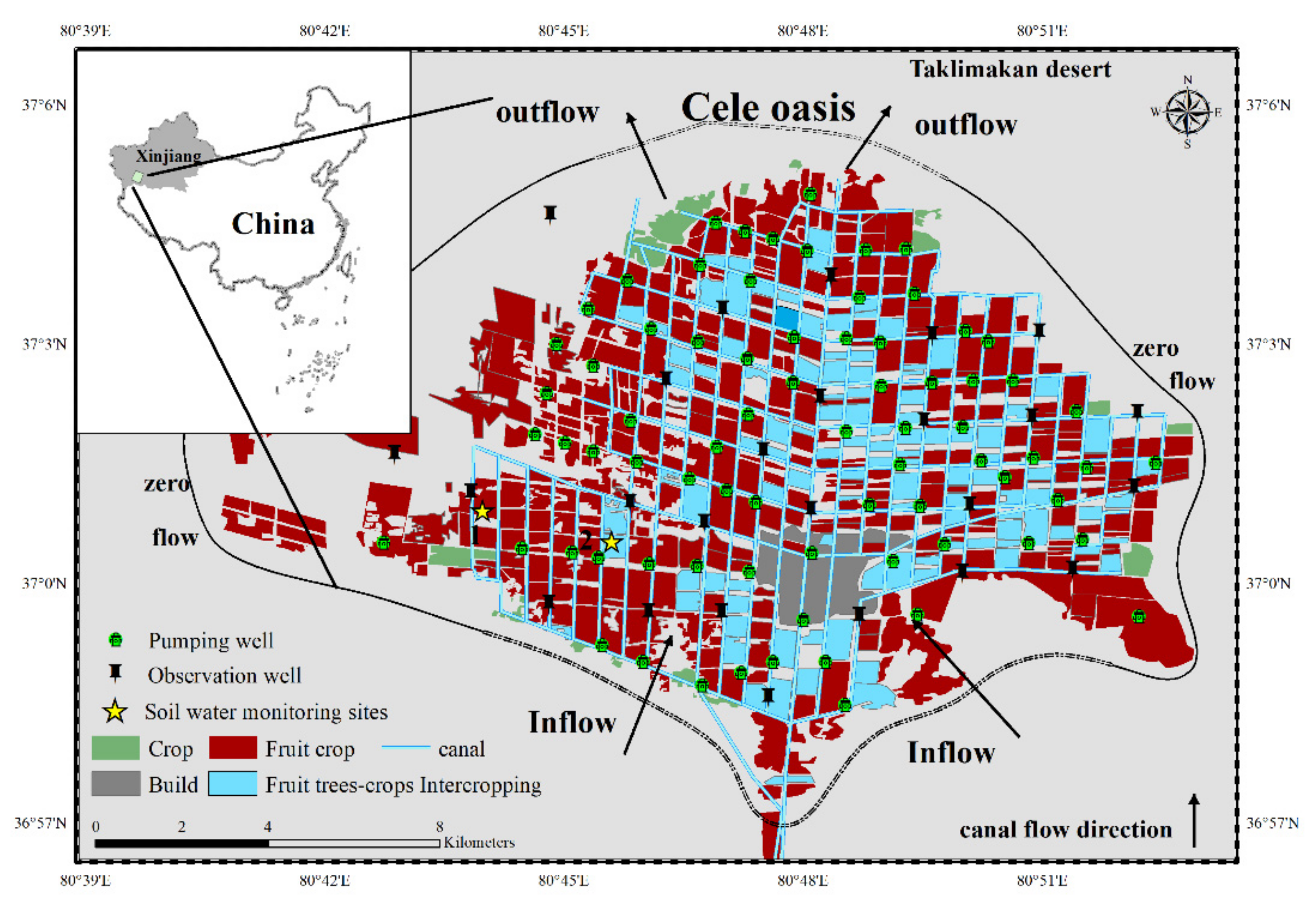

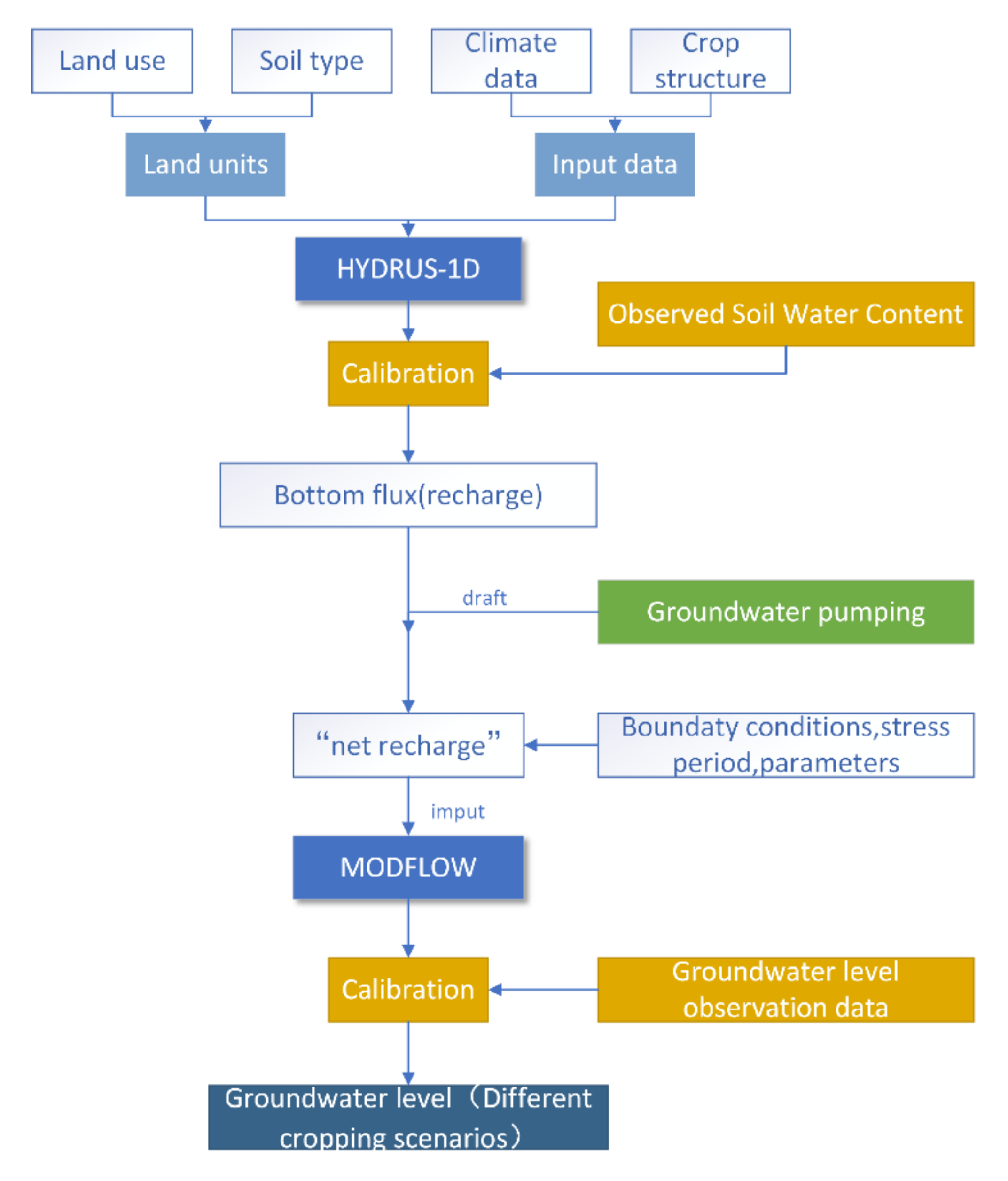
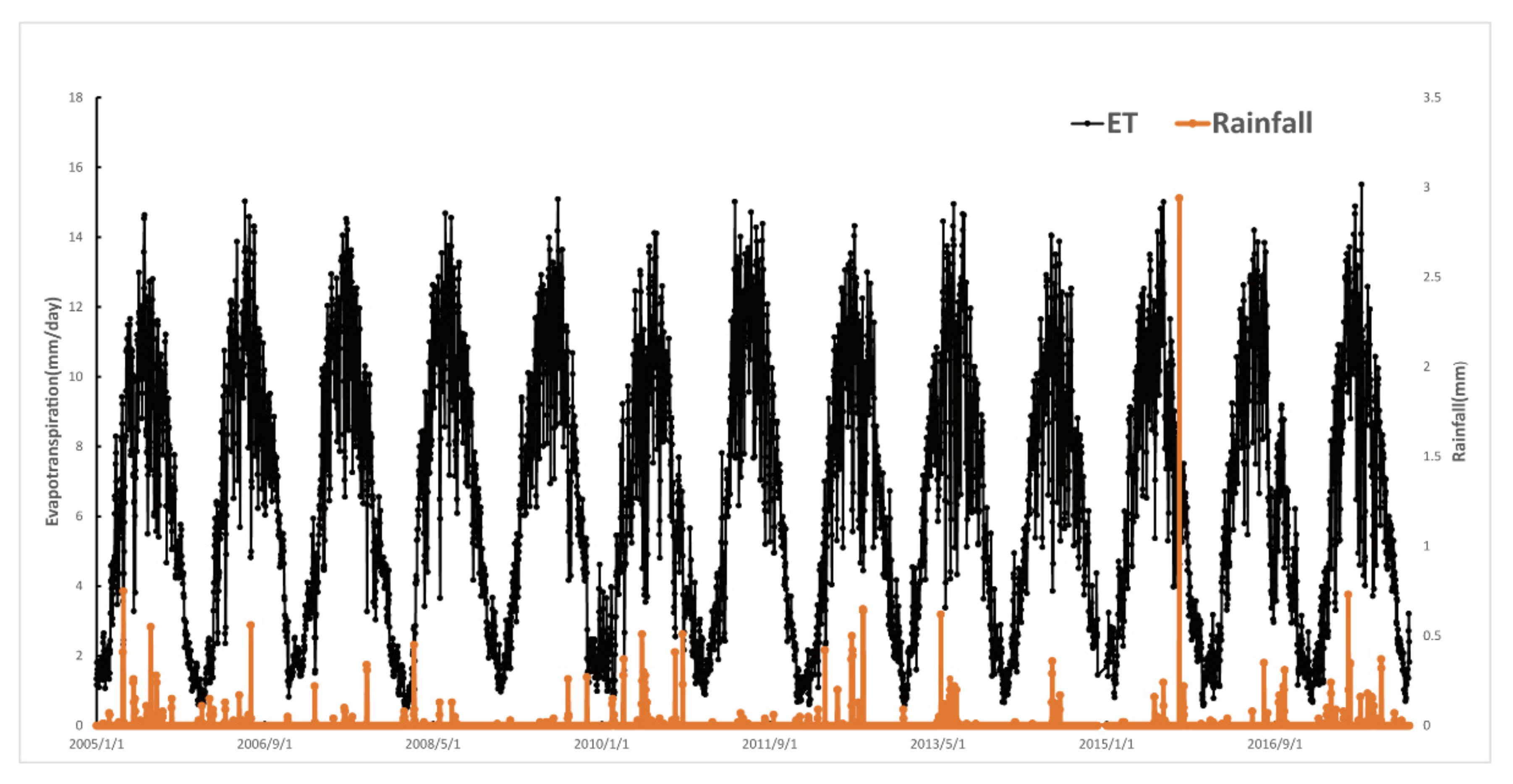
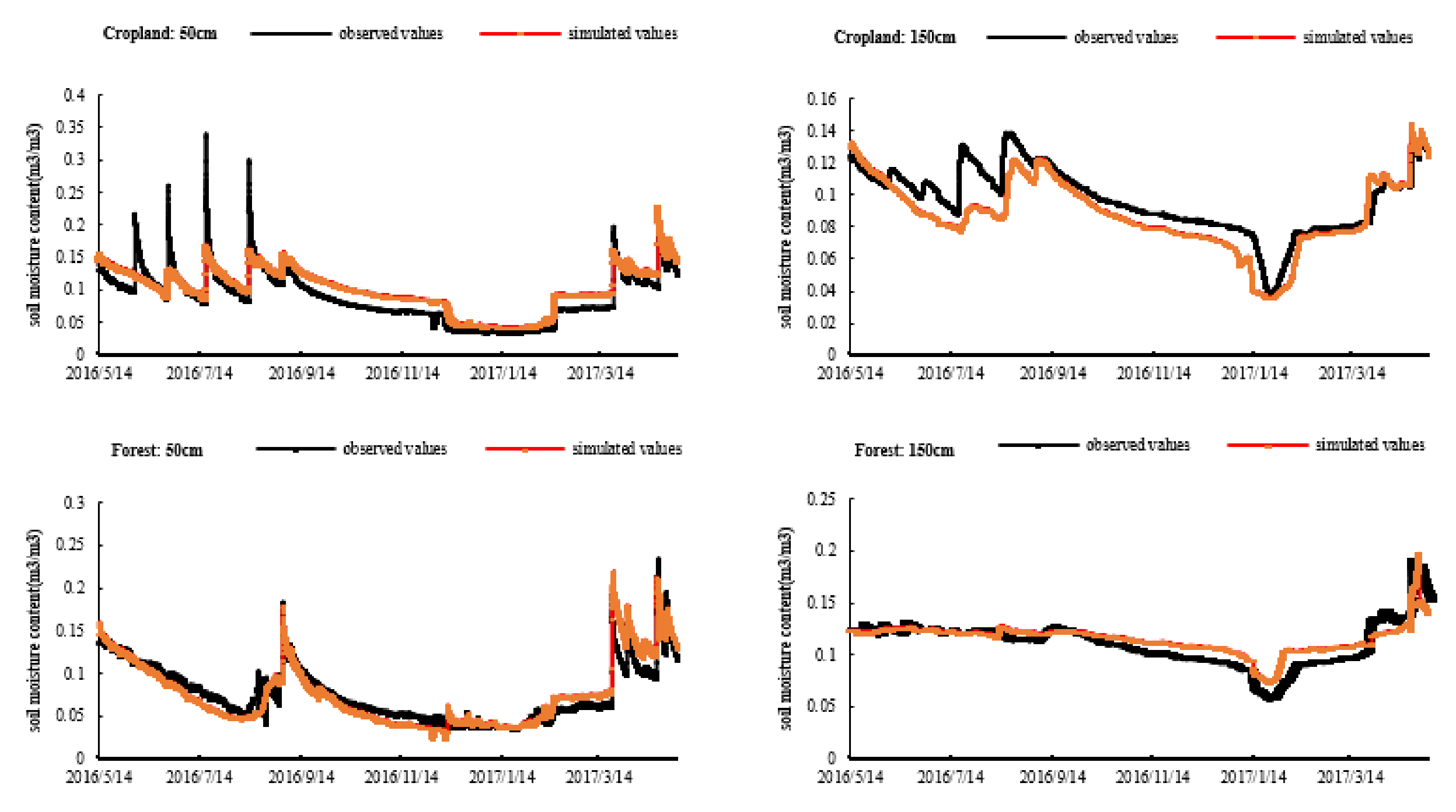

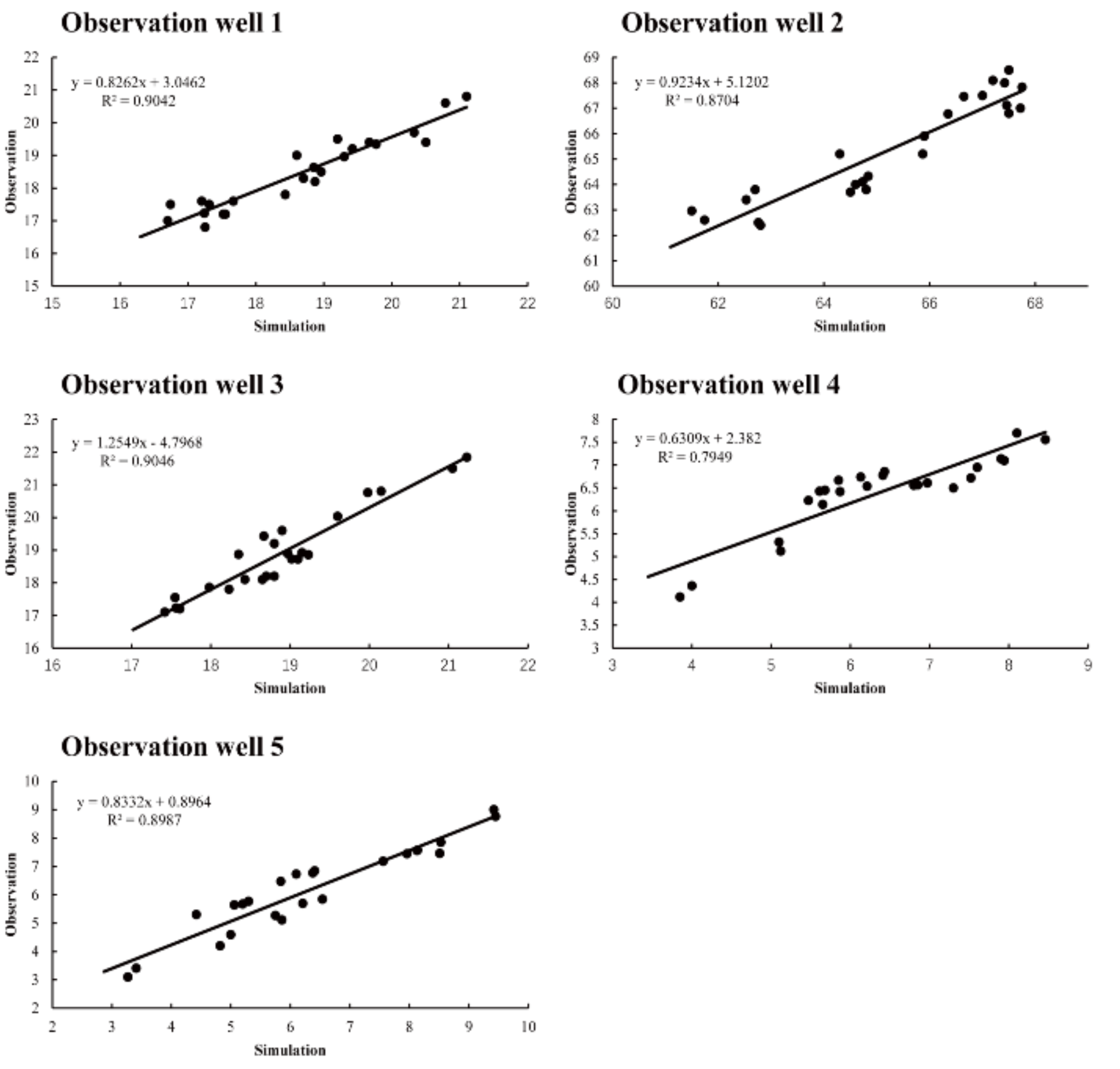
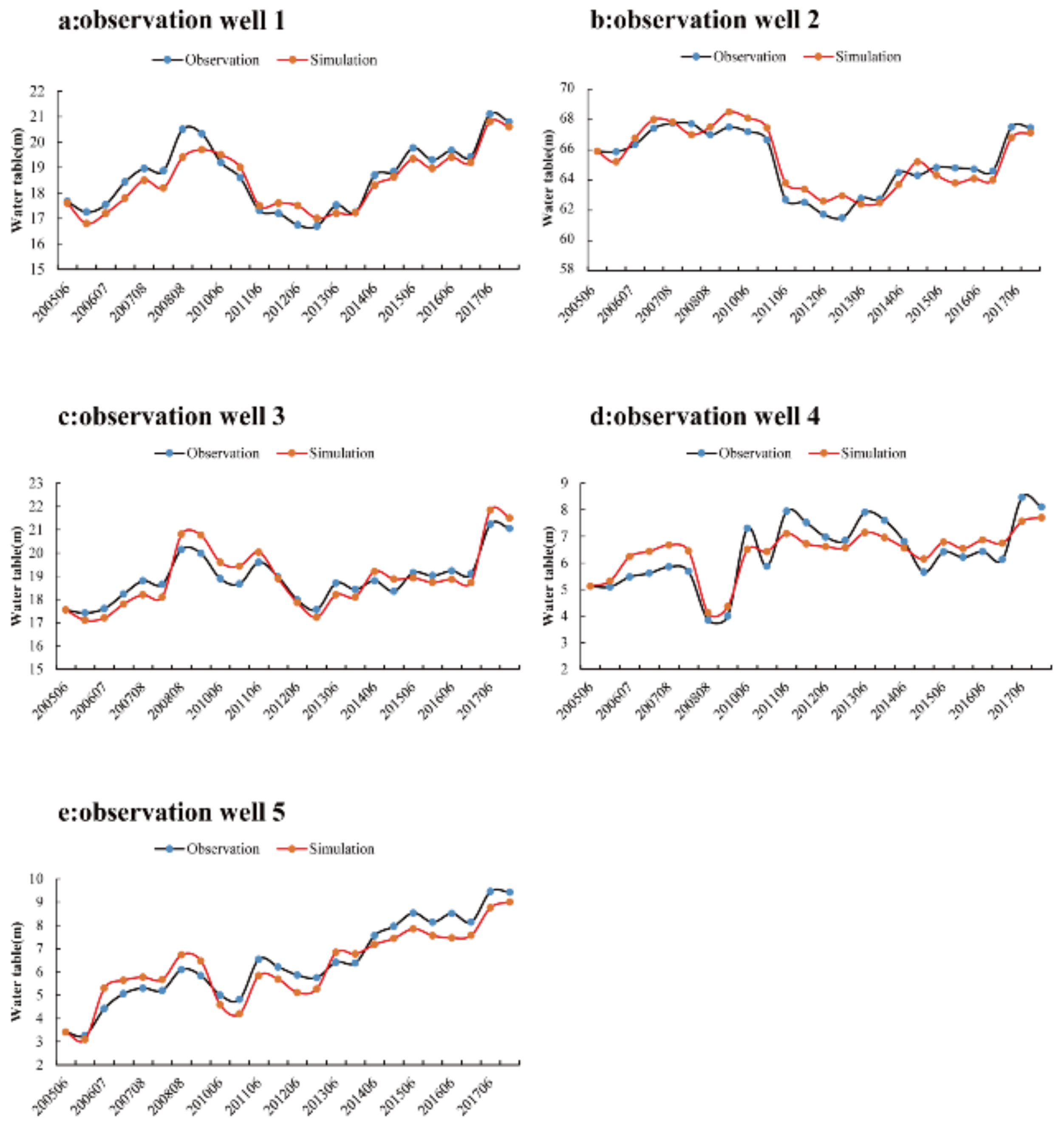
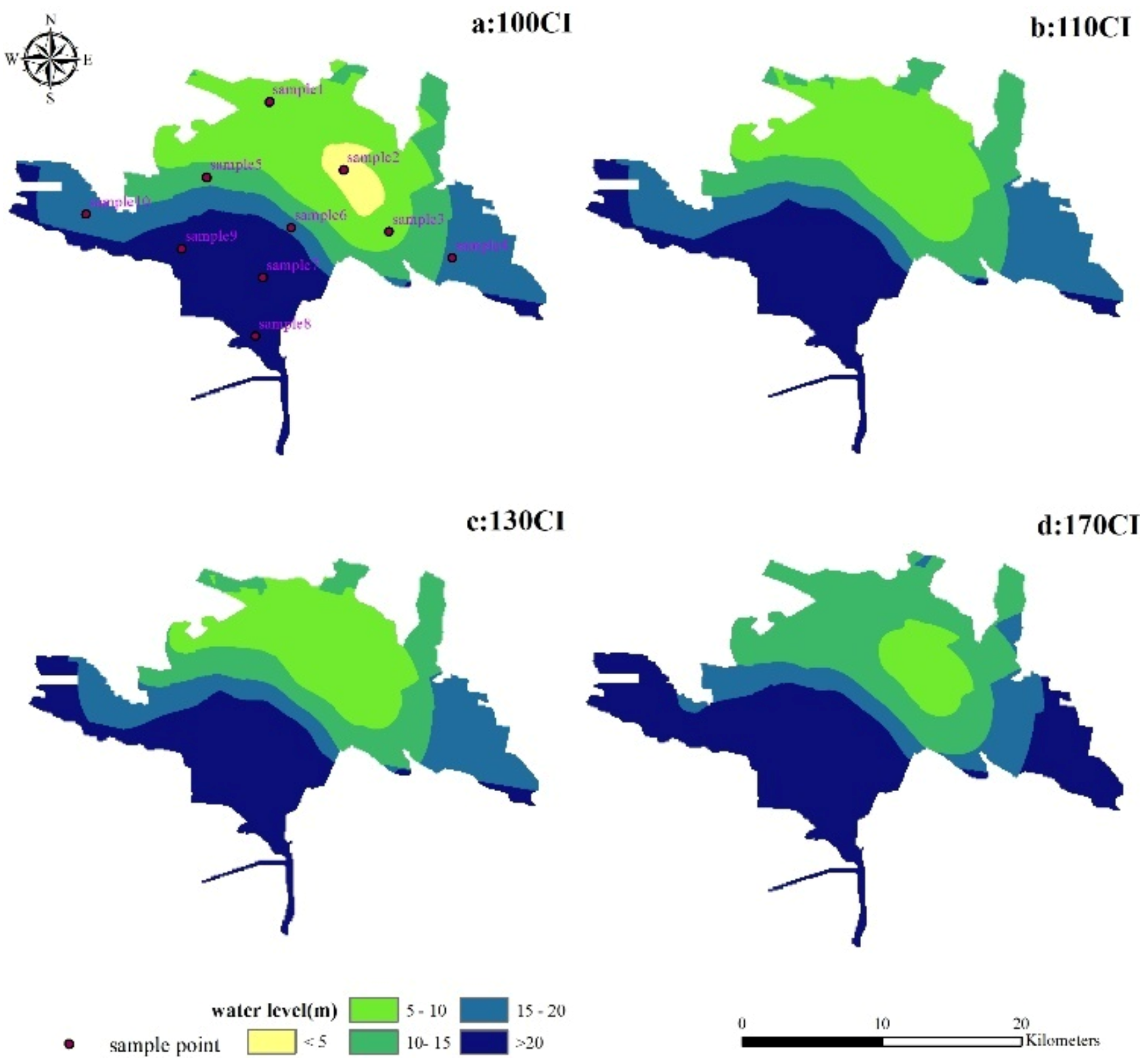
| Soil Type | Land Use | Land Unit | Area (km2) |
|---|---|---|---|
| Loamy sand | Cropland | CLS | 10.28 |
| Forest | FLS | 93.99 | |
| Build | BLS | 2.87 | |
| total | 107.14 |
| Land Use | Soil Type | θr (cm3cm−3) | θs (cm3cm−3) | α (cm−3) | n | Ks (cm day−1) | l |
|---|---|---|---|---|---|---|---|
| Cropland | Loamy sand | 0.06 | 0.524 | 0.031 | 1.57 | 102.3 | 0.5 |
| Forest | Loamy sand | 0.061 | 0.432 | 0.026 | 1.6 | 47.5 | 0.5 |
| Build | Loamy sand | 0.073 | 0.426 | 0.028 | 1.56 | 1.3 | 0.5 |
| Model Scenarios | Crop Intensity | Summer | Autumn | Winter | ||||||
|---|---|---|---|---|---|---|---|---|---|---|
| Forestry Fruit | Wheat * | Maize * | Forestry Fruit | Wheat | Maize | Forestry Fruit | Wheat | Maize | ||
| 100CI | 100 | 90 km2 | 10 km2 | 0 | 90 km2 | 0 | 10 km2 | 90 km2 | 10 km2 | 0 |
| 110CI | 110 | 90 km2 | 20 km2 | 0 | 90 km2 | 0 | 20 km2 | 90 km2 | 20 km2 | 0 |
| 130CI | 130 | 90 km2 | 40 km2 | 0 | 90 km2 | 0 | 40 km2 | 90 km2 | 40 km2 | 0 |
| 170CI | 170 | 90 km2 | 80 km2 | 0 | 90 km2 | 0 | 80 km2 | 90 km2 | 80 km2 | 0 |
| Soil Type | Land Use | Runoff (mm) | Root-Water Uptake (mm) | Bottom Flux (mm) |
|---|---|---|---|---|
| Loam sand | Cropland | 0 | 57.6 | 43.2 |
| Forest | 0 | 312 | 159.6 | |
| Build | 19.76 | - | 4.8 |
| Observation Well | R2 | RMSE | NSE |
|---|---|---|---|
| Well-1 | 0.90 | 0.45 | 0.87 |
| Well-2 | 0.87 | 0.74 | 0.86 |
| Well-3 | 0.87 | 0.47 | 0.76 |
| Well-4 | 0.77 | 0.59 | 0.76 |
| Well-5 | 0.89 | 0.58 | 0.85 |
| Random Sample | Base Year | 100CI | 110CI | 130CI | 170CI |
|---|---|---|---|---|---|
| Sample 1 | 7.02 | 0.25 | 1.41 | 1.65 | 4.21 |
| Sample 2 | 4.37 | 0.23 | 1.79 | 1.57 | 4.33 |
| Sample 3 | 7.96 | 0.34 | 1.91 | 1.73 | 4.07 |
| Sample 4 | 14.5 | 1.29 | 2.87 | 2.77 | 5.55 |
| Sample 5 | 12.4 | 0.65 | 1.32 | 2.00 | 4.16 |
| Sample 6 | 17.52 | 0.81 | 1.61 | 2.15 | 4.43 |
| Sample 7 | 42.3 | 2.98 | 4.05 | 4.54 | 7.07 |
| Sample 8 | 55.31 | 2.54 | 3.43 | 3.89 | 5.41 |
| Sample 9 | 23.1 | 2.84 | 3.69 | 4.15 | 3.09 |
| Sample 10 | 15.82 | 1.44 | 2.15 | 2.83 | 5.06 |
Publisher’s Note: MDPI stays neutral with regard to jurisdictional claims in published maps and institutional affiliations. |
© 2022 by the authors. Licensee MDPI, Basel, Switzerland. This article is an open access article distributed under the terms and conditions of the Creative Commons Attribution (CC BY) license (https://creativecommons.org/licenses/by/4.0/).
Share and Cite
Xue, D.; Dai, H.; Liu, Y.; Liu, Y.; Zhang, L.; Lv, W. Interaction Simulation of Vadose Zone Water and Groundwater in Cele Oasis: Assessment of the Impact of Agricultural Intensification, Northwestern China. Agriculture 2022, 12, 641. https://doi.org/10.3390/agriculture12050641
Xue D, Dai H, Liu Y, Liu Y, Zhang L, Lv W. Interaction Simulation of Vadose Zone Water and Groundwater in Cele Oasis: Assessment of the Impact of Agricultural Intensification, Northwestern China. Agriculture. 2022; 12(5):641. https://doi.org/10.3390/agriculture12050641
Chicago/Turabian StyleXue, Dongping, Heng Dai, Yi Liu, Yunfei Liu, Lei Zhang, and Wengai Lv. 2022. "Interaction Simulation of Vadose Zone Water and Groundwater in Cele Oasis: Assessment of the Impact of Agricultural Intensification, Northwestern China" Agriculture 12, no. 5: 641. https://doi.org/10.3390/agriculture12050641
APA StyleXue, D., Dai, H., Liu, Y., Liu, Y., Zhang, L., & Lv, W. (2022). Interaction Simulation of Vadose Zone Water and Groundwater in Cele Oasis: Assessment of the Impact of Agricultural Intensification, Northwestern China. Agriculture, 12(5), 641. https://doi.org/10.3390/agriculture12050641





